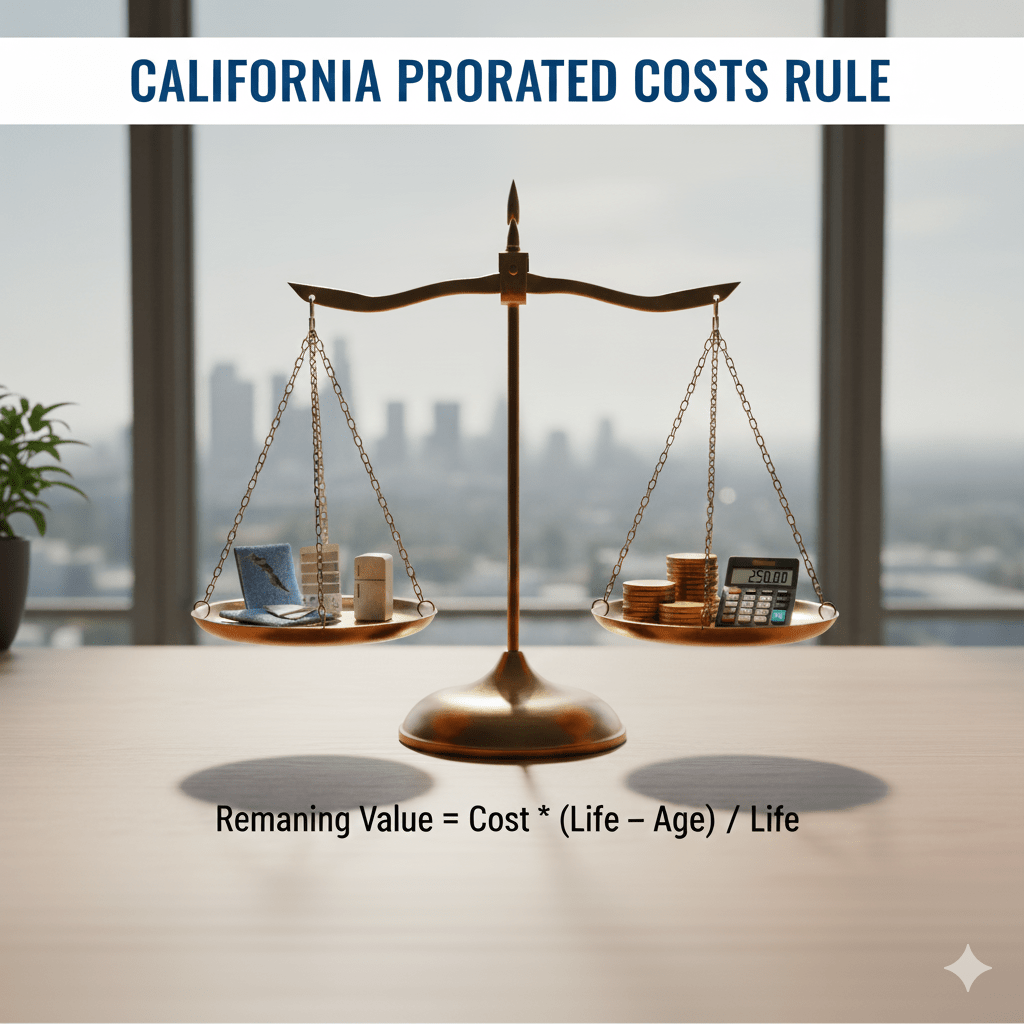
Property management in California comes with a strict set of regulations regarding security deposits, and one of the most critical for landlords to understand is the Prorated Costs Rule. This legal principle prevents a landlord from receiving a windfall—or profiting—from a tenant’s damage by charging the full replacement cost for an item that has already lost value due to age and use. Instead, the rule ensures that the deduction is based only on the item’s remaining value, or “useful life.”
The Prorated Costs Rule is a key differentiator between chargeable tenant damage and non-chargeable normal wear and tear. Understanding and correctly applying this rule is essential for lawful security deposit deductions and avoiding legal disputes.
⚖️ Prorated Costs vs. Wear and Tear
The first step in applying the rule is determining the nature of the damage. A landlord cannot deduct costs for normal wear and tear.
- Normal Wear and Tear: This refers to the natural, gradual deterioration that occurs with regular, everyday use. Examples include faded paint, minor wall scuffs, or worn carpet from foot traffic. Landlords must cover these costs as a normal part of property ownership and maintenance.
- Tenant Damage: This includes destruction or excessive degradation caused by accidents, negligence, or abuse by the tenant or their guests. Examples are a large wine stain on a carpet, a broken appliance from misuse, or holes punched in a wall. The Prorated Costs Rule applies only to this category of damage.
🛠️ How to Calculate the Prorated Deduction
Once a landlord establishes that the issue is tenant damage, they must calculate the fair deduction based on the item’s useful life and depreciation.
1. Estimate the Useful Life
“Useful life” is the expected lifespan of a component before it needs to be replaced due to normal use. While California does not have a single, official schedule, courts often reference industry standards.
| Item | Estimated Useful Life |
| Carpet | 5–10 years |
| Paint | 2–3 years |
| Appliances (e.g., Refrigerator) | Approximately 10 years |
| Blinds | 2–5 years (depending on quality) |
2. Apply the Proration Formula
The landlord is entitled to deduct the remaining value of the damaged item. This value is calculated by finding the item’s original replacement cost and subtracting the depreciation it has already incurred during its use.
Formula for Remaining Value: (Replacement Cost) x [(Useful Life – Age of Item at Damage) / Useful Life]
Example: Prorating a Damaged Carpet
Consider a scenario where a tenant severely damages a six-year-old carpet.
- Original Replacement Cost: $1,000
- Estimated Useful Life: 8 years
- Age of Carpet at Damage: 6 years
Step 1: Calculate Annual Depreciation
To find the value the carpet loses each year, divide the total replacement cost by the useful life:
- $1,000 (Replacement Cost) / 8 years (Useful Life) = $125 per year
Step 2: Calculate Remaining Value
The carpet had only two years of useful life remaining (8 years – 6 years). Multiply the annual depreciation by the remaining years:
- $125 per year x 2 remaining years = $250
In this case, the landlord could only deduct $250 from the security deposit for the damaged carpet. Charging the full $1,000 replacement cost would be a violation of the Prorated Costs Rule.
📝 Landlord Obligations for Legal Deductions
To legally utilize the Prorated Costs Rule, a landlord must adhere to several statutory requirements [California Civil Code § 1950.5]:
- Itemized Statement: Within 21 days after the tenant moves out, the landlord must send a written, itemized statement detailing any deductions from the security deposit.
- Documentation: For any deduction over $125, the landlord must provide invoices or receipts. If the landlord performed the repair work themselves, they must include a description of the work, the time spent, and a reasonable hourly rate.
- Pre-Move-Out Inspection: A tenant has the right to request a pre-move-out inspection and an itemized list of potential repairs. This gives them an opportunity to fix the issues themselves and avoid deductions.

Kurt Galitski- Principal, Broker
(949) 688 7705 | DRE #: 01348644
2919 Newport Blvd, Newport Beach, CA 92663
DISCLAIMER: This article is for informational and educational purposes only and is based on publicly available data from official state and county sources. We are NOT tax professionals, financial advisors, CPAs, or attorneys. The information provided does not constitute legal, tax, or financial advice.